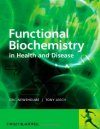By: Eric A Newsholme(Author), Tony R Leech(Author)
543 pages, b/w illustrations, tables
![Functional Biochemistry in Health and Disease Functional Biochemistry in Health and Disease]()
Click to have a closer look
About this book
Contents
Customer reviews
Related titles
About this book
This text provides a clear and straightforward account of the biochemistry that is necessary to understand the physiological functions of tissues or organs essential to the life of human beings. Focusing on the dynamic aspects of biochemistry and its application to the basic functions of the body, the book bridges the gap between biochemistry and medical practice. Carefully structured within five sections, each biochemical, physiological or medical subject that is covered in the book is presented in one complete chapter. Consequently, each subject can be read and studied in isolation although cross-sectional links between the subjects are included where necessary. Background material, both biochemical and medical, that is necessary for an understanding of the subject, is included at the start of each chapter and clear, simple but relevant diagrams enhance students' understanding.
This book focuses on medically relevant aspects of biochemistry written from a physiological rather than a molecular perspective. It offers clear presentation that minimises the use of jargon. Each chapter contains boxes on related topics, relevant diagrams and a brief glossary. Coverage includes athletic performance, cell growth and the immune system. Key historical developments are included to show how modern biochemistry has evolved. By linking biochemistry, medical education and clinical practice this book proves invaluable to students in medical and health sciences, biomedical science and human biology. In addition it is of interest to biochemistry and biology students interested in clinical applications of biochemistry.
Contents
Preface
INTRODUCTION
1. A biochemical hierarchy: from the cell to its Human
ESSENTIAL TOPICS IN BIOCHEMISTRY, PHYSIOLOGY AND BIOLOGY
2. Energy: in the body, tissues and biochemical processes
3. Enzymes: their properties, regulation and physiology
4. Transport into the body: the gastrointestinal tract, digestion and absorption
5. Transport: into the cell
ESSENTIAL METABOLISM
6. Carbohydrate metabolism
7. Fat metabolism
8. Amino acid and protein metabolism
9. Oxidation of fuels and ATP generation
10. Metabolism of Ammonia: degradation of nucleotides; the ornithine cycle
11. Synthesis of fats, fatty messengers and cholesterol
12. Hormones: chemical communication
ESSENTIAL PROCESSES OF LIFE
13. Physical activity: in non-athletes, athletes and patients
14. Acid/Base balance in normal and pathological states
15. Mental activity and mental illness
16. Nutrition
17. Starvation
18. Mechanisms of defence: barriers, enzymes and the immune system
19. Trauma
20. Sexual reproduction
COMMON CLINICAL PROBLEMS AND DISEASES
21. Growth of cells and the skeleton
22. Atherosclerosis, hypertension and myocardial infarction
23. Cancer
24. Eating disorders: anorexia nervosa and bulimia nervosa
25. Obesity and adipose tissue
26. Lipoprotein metabolism and dyslipoproteinaemias
Customer Reviews
By: Eric A Newsholme(Author), Tony R Leech(Author)
543 pages, b/w illustrations, tables
"Functional Biochemistry in Health and Disease provides a clear and straightforward account of the biochemistry that is necessary to understand the physiological functions of tissues or organs essential to the life of human beings'. The book makes a strong connection between biochemistry and medical practice."
– Australian Biochemist, December 2010



































